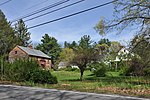Middlesex Community College (Massachusetts)
1970 establishments in MassachusettsBedford, MassachusettsCommunity colleges in MassachusettsEducation in Lowell, MassachusettsMiddlesex Community College (Massachusetts) ... and 3 more
Two-year colleges in the United StatesUniversities and colleges established in 1970Universities and colleges in Middlesex County, Massachusetts
Middlesex Community College is a public community college with two campuses in Massachusetts, one in Lowell and the other in Bedford.
Excerpt from the Wikipedia article Middlesex Community College (Massachusetts) (License: CC BY-SA 3.0, Authors).Middlesex Community College (Massachusetts)
Springs Road,
Geographical coordinates (GPS) Address Website Nearby Places Show on map
Geographical coordinates (GPS)
| Latitude | Longitude |
|---|---|
| N 42.524494444444 ° | E -71.274147222222 ° |
Address
Middlesex Community College
Springs Road
01865
Massachusetts, United States
Open on Google Maps










